Your Backyard Wildlife Habitat: Sweet and Sour in Summer, Poison Ivy!
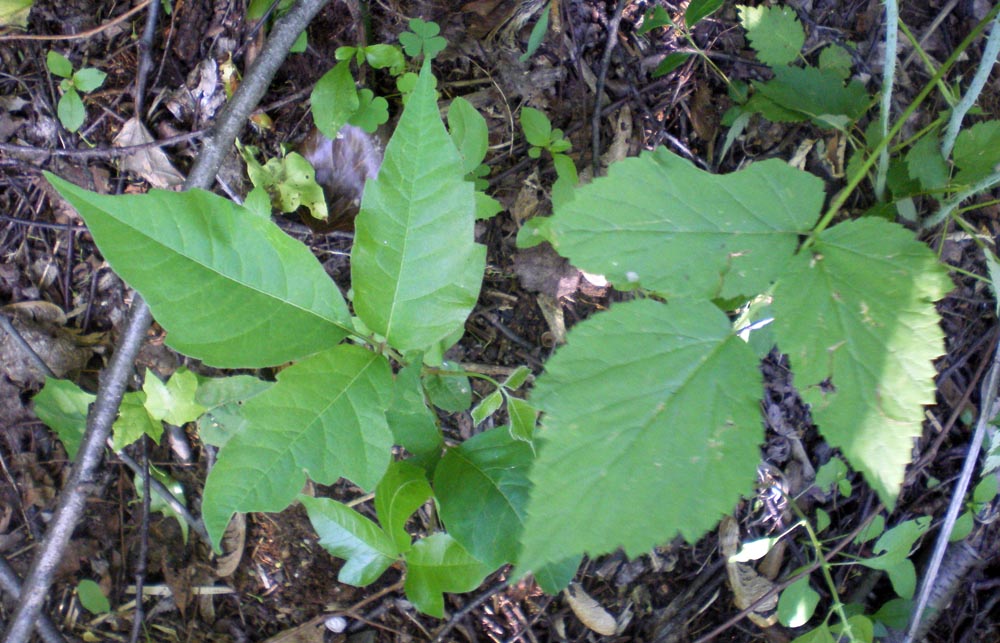
Itch. Itch. Scratch scratch. Scratch scratch scratch scratch scratch DIG DIG—aaaggghhh!
No, it’s not your cat or dog, it’s you! And what’s the culprit? Poison ivy! But you’ve been wearing work clothes in an office all week, where the heck did it come from?
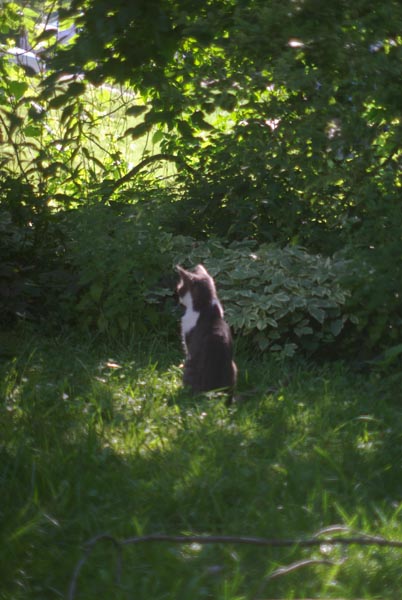
Does your cat visit your yard where, perhaps, in some corner very exciting to kitties there might be a vine with three leaflets climbing a tree or fence you’d never noticed before? Did you walk your dog along a trail in the woods and not notice in the undergrowth the familiar three leaflets growing among the wildflowers when your dog ran off trail after a squirrel?
The good news is that cats and dogs are not nearly as sensitive to poison ivy as we humans with our hairless skin. For the most part their fur protects their skin so the oil that causes the allergic reaction doesn’t have a chance to torture them. And even if they do get their noses into it or areas where their fur is thin like ears, bellies and genital areas, most animals will not react to it at all, though I have heard of a few cases where an apparent allergic reaction in a cat or dog looked a heck of lot like a poison ivy rash, and mysterious allergic reactions in pets, even eye irritation and upper respiratory issues, have also been attributed to contact with poison ivy, oak or sumac.
The bad news is that they can easily transfer the oil from their fur to you as if you had directly contacted it. A friend recently complained of an itchy rash on her neck and chest and upper arms, sparse but annoying all the same, and not too many things are itchy in quite the same way as poison ivy though she wasn’t aware of being anywhere near an area where she’d encounter it. Then she noticed the rash had “edges” in roughly the shape of the neckline of her nightgown…aha, her kitties visited the back yard, there was poison ivy in some of the corners, and that was exactly where each of them, at one time or another, cuddled against her during the night.
Identifying poison ivy, and telling the sweet from the sour
Two opportunistic and fast-growing native plants indicative of summer grow together in much of North America, and you’ll find them along trails, at the edge of woods or parking lots, in overgrown areas and open lots, and even in your own back yard. One provides a sweet treat, though, while the other provides only the sour of itching agony—so be careful of the poison ivy leaves when you reach for those tempting burgundy berries during summer, and when you are working in your yard take note of the shape and color before you get your hands on them!
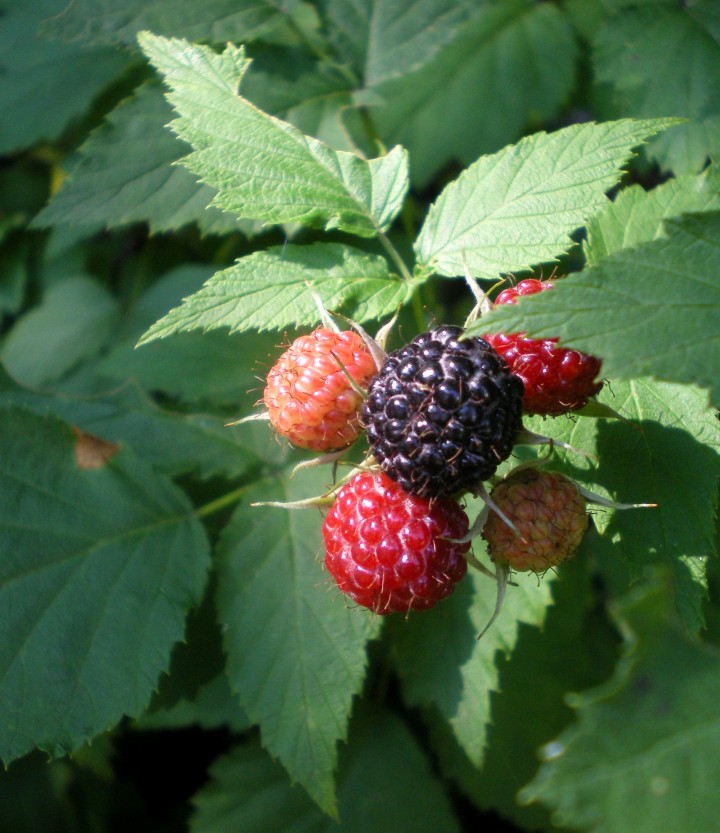
They’ll show up in cleared areas in the first summer after clearing, sprouting from a wooded area and growing along the edges and spreading quickly into the newly cleared area because of the sunlight, putting down roots intending to stay once taller plants and trees grow around them. Both plants are perennials and once established develop extensive root systems from which shoots can spring up quite a distance away. Once they’re in place, there’s not much you can do but dig them out completely, and our wooded areas are full of them—as is the area under my neighbor’s trees that isn’t cut too often, which proves they’re not particular about where they’ll grow if the conditions are right.
But avoiding poison ivy is no reason to avoid trails and natural areas if you enjoy them or maintain a natural area in your yard. Like the wolf in sheep’s clothing, the leaves of both young plants in early summer look enough alike to be confused since they are about the same size, shape and color and grow in clusters of three, and most of us remember the old adage: “Leaves of three, let it be“.
Raspberry leaves, below right, are a slightly darker shade of green and have serrated edges, plus the stems, and even the undersides of some leaves, have thorns which are tiny but present when they are young. The plant also tends to grow in a clump with several unbranched canes of varying lengths sprouting from one central point. Tiny white five-petaled blossoms show in May and clusters of berries from immature green to mature maroon are evident from late May through June.
Poison ivy leaves, below left, even when young, have smooth edges and are nearly always shiny. They also tend to be a lighter, brighter green than other plants around. While the plant is most commonly a vine which grows along the ground and twines up anything it can find, it will sometimes form an upright plant like a bush or small tree, but it never has thorns. Berries are white and don’t appear until later in the year. But the leaves aren’t always consistent—you’ll see smaller and larger together, sometimes a few loose lobes around the edge and sometimes they are very deeply cut, like the leaflet at the bottom of this cluster of three, which makes it look like another plant entirely. Also note that the tiny, shiny leaflet underneath is also poison ivy.
Let’s look at those leaves again!

How does it get into your yard?
First, both plants’ runners can grow long distances in the soil, underneath paved areas such as streets and buildings and pop back up quite a distance away.
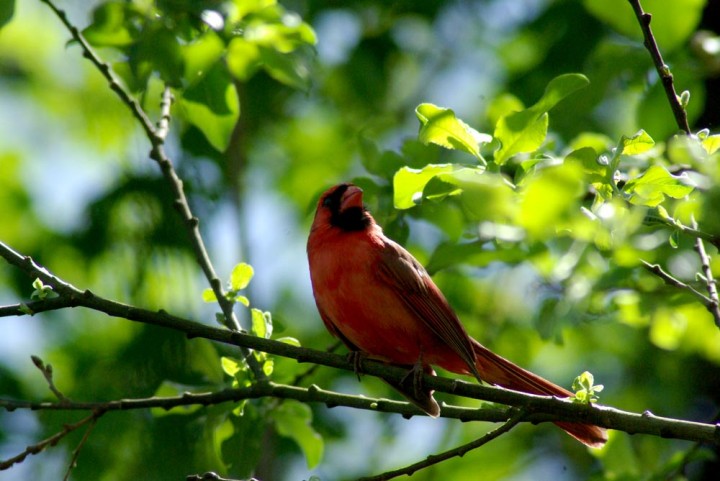
Second, you know those sweet little birds you faithfully feed, who serenade you every morning and entertain your cats through the day? In the big circle of nature they have an important role in assisting the spread and reproduction of many native plants within their ecosystem, and it’s really easy for them—eat berries and digest the nourishing flesh and, um, expel the seed along with, uh, a proper amount of, well, fertilizer….you get the picture. Native berries, including both raspberries in the spring and poison ivy berries in the fall, are one of their main food sources, so you’ll often them sprouting underneath areas where birds often perch.
What makes you itch?
I thought it unfair when I was little and saw that I had to reach past poison ivy leaves to get my June treat, but I learned that I’m one of the fewer than 10% of people who don’t get an immediate reaction to poison ivy and I often won’t develop an apparent rash at all, but when I clear out my gardens and along my fences in spring by pulling the plant I’ll get a rash if I pull out enough of it—no one is totally free of poison ivy sensitivity. My brother, on the other hand, will develop a systemic rash that can only be cleared up with steroids if he so much as looks at poison ivy. Guess we got different genetics!
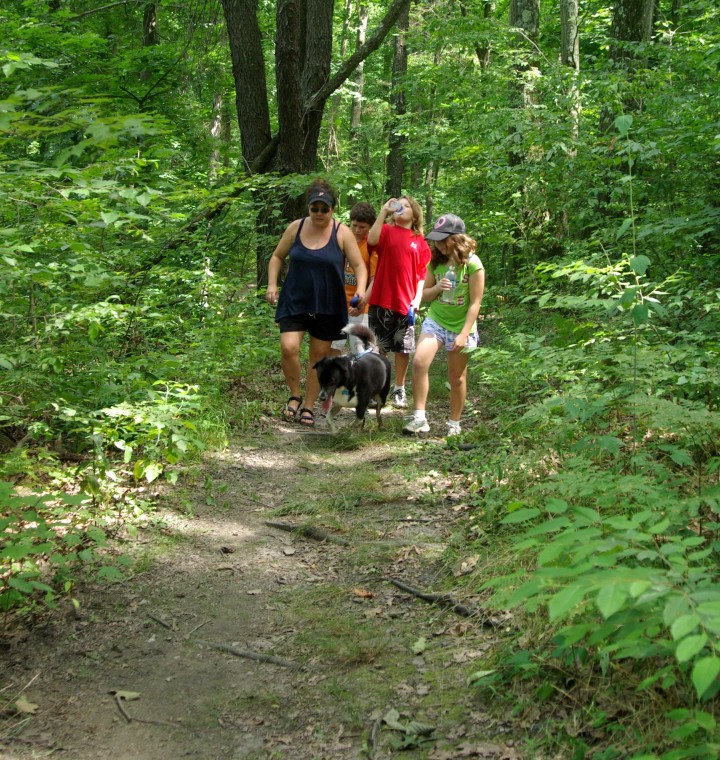
It’s the “urushiol oil” in the plant that contains the irritant, and this can be found in all parts of the plant including the roots, as I learned years ago working in my yard in February the year after I moved in, excitedly clearing an area of my new yard during the spring thaw and developing a rash a few days later. You can be exposed by touching the plant yourself, and also by touching your clothing which may have come in contact with the plant, even by petting your dog who may have run through it in the woods and happily carried it back on his fur, or your cat who has explored that really exciting area you’ve let get overgrown for wild critters at the end of your yard and come back to give you head butts and body rubs. You can also contact it in much more passive ways, even breathing the oils when it’s been disturbed, cut or burned.
Alleviating the itch “in the field”
Washing and rinsing an affected area immediately after exposure can help to reduce the effects of the oil, but it must be done with a substance that can dissolve the oil and it must be rinsed away in order to be effective. For this reason waterless cleaners and wipes that many people carry on a hike today are apparently not too effective because they don’t dissolve oils and you don’t rinse away the contaminant, and in many cases they can help to spread the oil further.
Carry a chip of bar soap with you, place it in an old sock and tie a knot in the open end. When you need to use it just pour some water from your water bottle over it to dampen it or dip it in a puddle or stream and rub it between your hands to lather it a little. Wipe this over the areas where the poison ivy oil touched your skin and even gently wipe down the surface of your pet’s fur, then follow with a rinse using a damp cloth that has not touched any poison ivy. That may seem a little primitive, but I’ve always carried something along these lines in my little first aid kit for when I’m out on the trail.
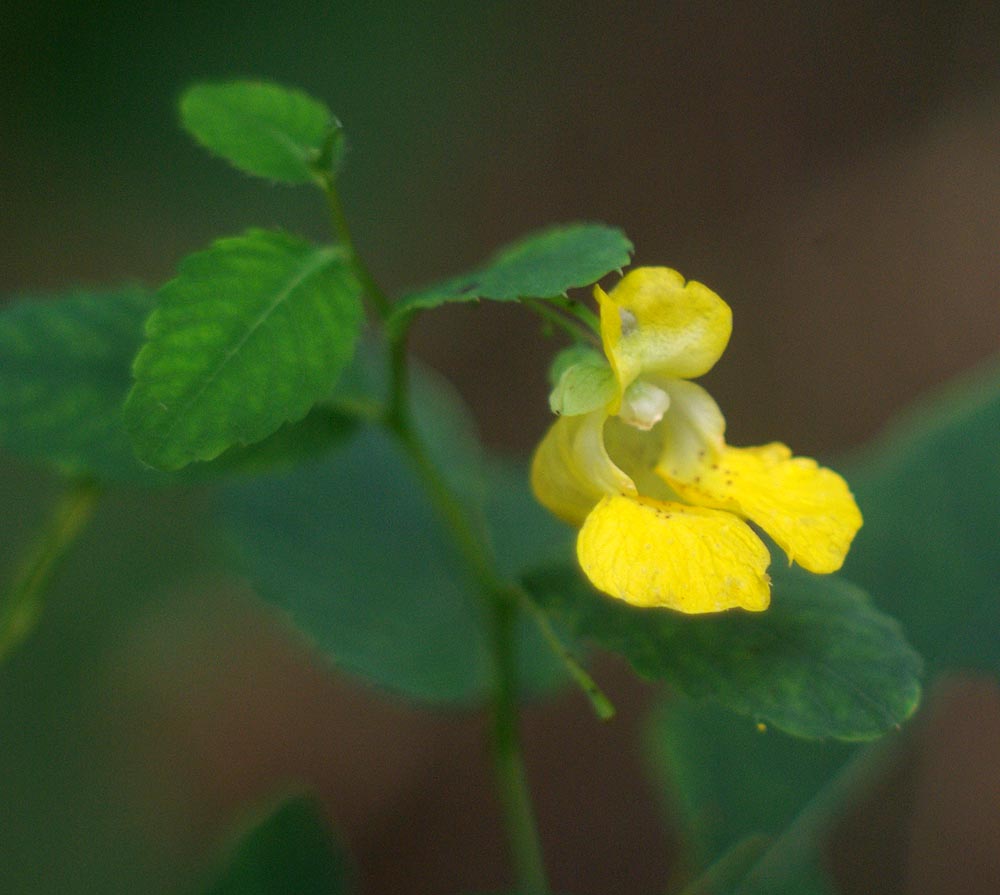
You can also look for another native plant that always grows near poison ivy called “jewelweed”, related to our familiar annual flower impatiens (look closely at the leaves to see the similarity). The juice in the flowers, leaves and stems can help to neutralize and rinse away the oil to a certain extent, and alleviate the itch, either by taking a handful and crushing them then rubbing onto the area, or gathering some flowers and leaves and making a tea to cool and use later.
Raspberries, on the other hand, offer only pleasure eaten fresh or made into a pastry or a preserve—except for those pesky thorns, or course.
In July you’ll see our other native berry, the blackberry, but while poison ivy grows together with blackberries as well, the matured poison ivy leaves and stems are more easily distinguished from blackberries because, while the leaves can look similar and the young canes are green, mature blackberry canes are a wonderful burgundy and all canes have are frosted with pale green.
Bear in mind that both berries are an important food source for our native birds and other wildlife (which is how the plants are often spread), so if you find them outside of your yard, indulge in a few as a refreshing treat while you’re walking but it’s best to leave them on the bush and buy them from a local farmer.
Managing it without using chemicals
Can you dig it?
Sorry, couldn’t pass up the pun. Yes, digging up the clump and getting all the roots is hard work, but this is the only way to truly eradicate poison ivy. This can be difficult if it’s growing among other things you want to keep, or if it’s growing as it often does—next to a tree so that the plant’s roots are entangled with the tree’s roots.
Cut it
If you can’t remove the roots, you can cut it repeatedly and as often as possible. Plants need to photosynthesize to live, and they need leaves to photosynthesize, so if you remove the leaves the plant’s stems will eventually die off, though runners can still form and run off somewhere else to sprout.
Cover it
You can place a barrier over it so that it simply can’t sprout through the soil. My yard was hugely over grown on a little hillside area when I moved in, and I cut and pulled as many sumacs, grapevines, poison ivy and more invasive plants when I moved in, then covered the rest with heavy plastic and covered that with rough wood chips from an arborist friend. A few things sprouted up around the plastic that I could easily cut with my mower, but it got the worst of these plants under control without the need to constantly maintain.
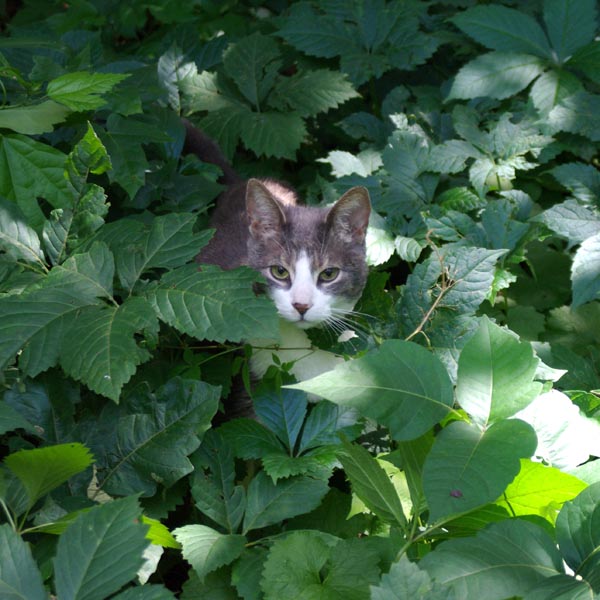
A homemade non-toxic defoliant spray
And if it keeps entering your yard from other areas or you can’t pull, cut or cover it in any way, you can defoliate it with a homemade spray that is non-toxic to you, pets, wildlife or beneficial insects, and will destroy the leaves. Baking soda will burn the leaves and young stems of any plant it touches. Here’s the mix:
- pint of water mix
- tablespoon of dish soap
- quarter cup of baking soda
Mix it well and spray it onto the leaves and stems of the poison ivy, coating top and bottom sides of the leaves. The dish soap is just “sticky” enough that it will help your mixture cling to the leaves and it will break down the leaf’s protective coating so that the baking soda has a chance to burn the leaf surfaces, which in a few days will shrivel. If they don’t, mix it with a little more baking soda and spray it again. You can also use vinegar in place of half the water and not include the baking soda because the vinegar will also burn the leaf surface, but I find the baking soda clings to the leaves longer and does more damage. Be careful that it doesn’t drip on anything you want to keep!
The valuable thing about this method is that you are not releasing any oils into the air, so if you or anyone around is highly allergic to poison ivy they won’t be affected when you spray the leaves.
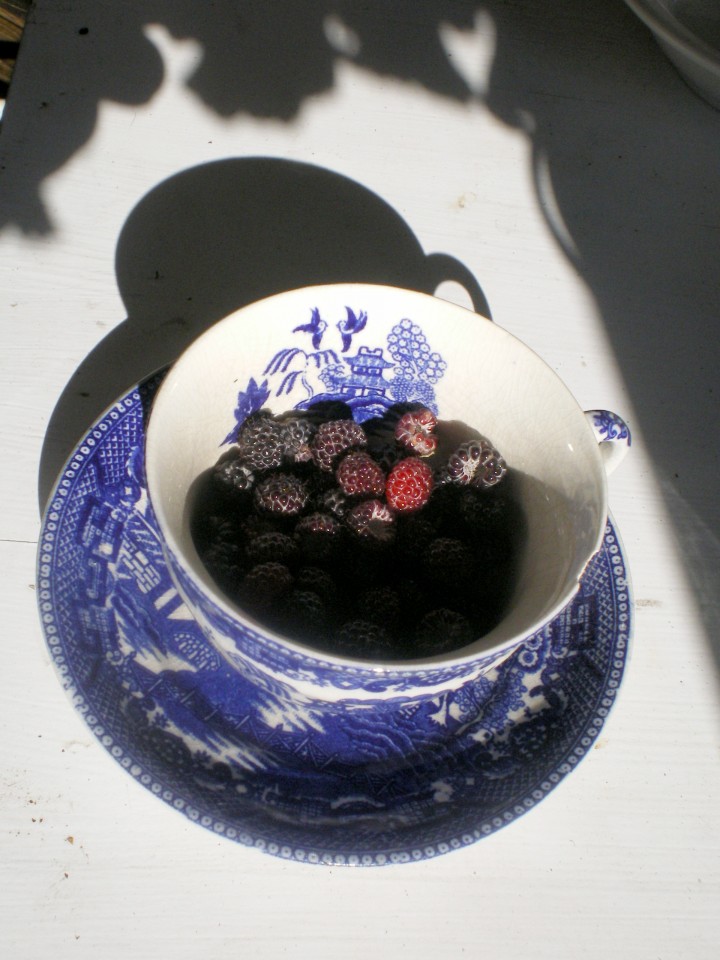
I discovered this while mixing a standard non-toxic spray for aphids and mold and mildew diseases on my roses, but the mix should have contained only a tablespoon of baking soda to manage the insects and diseases without harming the plant. I unfortunately defoliated the areas of my roses which I’d sprayed (it did take care of the aphids and mildew, though), and decided to try it on other invasive plants I couldn’t pull for one reason or another. I actually use this for anything I need to defoliate without harming other plants, such as an aggressive plant that’s managed to sprout among my vegetables or flowers.
If you still find it hard to tell poison ivy from berries or other plants, just stay on the trail, wear pants or socks, which is advised in the woods especially for protection from ticks, and avoid any plant that has three leaflets. My favorite source for information about poison ivy is on the internet at www.poisonivy.aesir.com/view/welcome.html.
Pets and Poison Ivy, Oak and Sumac
Poison Ivy, Poison Oak, Poison Sumac and Pets on About.com Veterinary Medicine
~~~~~~
Poison Ivy and Wildlife
Poison Ivy—A Wildlife Food—One Of First Plants To Change Color
~~~~~~
About Jewelweed and other traditional remedies and treatments for poison ivy rash
Poison Ivy – Alcohol, water, soap, and maybe a little Jewelweed.
Read other articles in the category of Your Backyard Wildlife Habitat
If you’re interested in more information about Backyard Wildlife Habitats, choose the category Your Backyard Wildlife Habitat for a list of articles in this series, visit the Backyard Wildlife Habitat page for a series articles on developing your habitat or choose the category Backyard Wildlife Habitat to find all posts sharing the articles, photos, paintings and sketches, poetry and prose I’ve done that were inspired but my backyard.
All images used on this site are copyrighted to Bernadette E. Kazmarski unless otherwise noted and may not be used without my written permission. Please ask if you are interested in using one in a print or internet publication. If you are interested in purchasing a print of this image or a product including this image, check my Etsy shop or Fine Art America profile to see if I have it available already. If you don’t find it there, visit Ordering Custom Artwork for more information on a custom greeting card, print or other item.
Subscribe to The Creative Cat on your Kindle


Start with a 14-day free trial. You can cancel at any time during the free trial period. If you enjoy your subscription, do nothing and it will automatically continue at the regular monthly price of 99 cents. Click here to subscribe to The Creative Cat on your Kindle.
© 2014 | www.TheCreativeCat.net | Published by Bernadette E. Kazmarski
—
Weekly schedule of features:
Sunday: Essays, Pet Loss, Poetry, The Artist’s Life
Monday: Adoptable Cats, TNR & Shelters
Tuesday: Rescue Stories
Wednesday: Commissioned Portrait or Featured Artwork
Thursday: New Merchandise
Friday: Book Review, Health and Welfare, Advocacy
Saturday: Your Backyard Wildlife Habitat, Living Green With Pets, Creating With Cats
And sometimes, I just throw my hands in the air and have fun!
—


Hello,
Great article on poison ivy and I love that you put the raspberry side by side with it. I had trouble telling those two apart when we first moved to the Midwest.
Glad you enjoyed my jewelweed article enough to link to it.
Misty 🙂